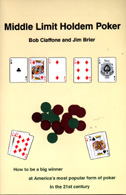
Middle Limit Hold'em Poker
Robert's Rules of Poker - Hold'em Poker, Including Irregularities
Robert's Rules of Poker was written by Robert Ciaffone. The goal of this rulebook is to produce the best set of rules in existence, and make it generally available, so any person or cardroom can use Bob Ciaffone is one of America’s best-known poker players, writers, and teachers. He has numerous poker tournament wins and placings, the most prominent being third place in the 1987 World Championship. He has been a poker teacher since 1995, with his students having earned well over a million dollars in tournament play. Bob's website is www.pokercoach.us it who so desires. The purpose is the betterment of poker.
Bob Ciaffone is one of America’s best-known poker players, writers, and teachers. He has numerous poker tournament wins and placings, the most prominent being third place in the 1987 World Championship. He has been a poker teacher since 1995, with his students having earned well over a million dollars in tournament play. Bob's website is www.pokercoach.us it who so desires. The purpose is the betterment of poker.
The following section concerns the rules for playing hold'em.
In hold'em, players receive two downcards as their personal hand (holecards), after which there is a round of betting. Three boardcards are turned simultaneously (called the “flop”) and another round of betting occurs. The next two boardcards are turned one at a time, with a round of betting after each card. The boardcards are community cards, and a player may use any five-card combination from among the board and personal cards. A player may even use all of the boardcards and no personal cards to form a hand (play the board). A dealer button is used. The usual structure is to use two blinds, but it is possible to play the game with one blind, multiple blinds, an ante, or combination of blinds plus an ante.
RULES
These rules deal only with irregularities. See the previous chapter, “Button and Blind Use,” for rules on that subject.
1. If the first or second holecard dealt is exposed, a misdeal results. The dealer will retrieve the card, reshuffle, and recut the cards. If any other holecard is exposed due to a dealer error, the deal continues. The exposed card may not be kept. After completing the hand, the dealer replaces the card with the top card on the deck, and the exposed card is then used for the burncard. If more than one holecard is exposed, this is a misdeal and there must be a redeal.
2. If the dealer mistakenly deals the first player an extra card (after all players have received their starting hands), the card will be returned to the deck and used for the burncard. If the dealer mistakenly deals more than one extra card, it is a misdeal.
3. If the flop contains too many cards, it must be redealt. (This applies even if it were possible to know which card was the extra one.)
4. If before dealing the flop, the dealer failed to burn a card, or burned two cards, the error should be rectified if no cards were exposed. The deck must be reshuffled if any cards were exposed.
5. If the dealer fails to burn a card or burns more than one card, the error should be corrected if discovered before betting action has started for that round. Once action has been taken on a boardcard, the card must stand. Whether the error is able to be corrected or not, subsequent cards dealt should be those that would have come if no error had occurred. For example, if two cards were burned, one of the cards should be put back on the deck and used for the burncard on the next round. If there was no betting on a round because a player was all-in, the error should be corrected if discovered before the pot has been awarded.
6. If the dealer burns and turns before a betting round is complete, the card(s) may not be used, even if subsequent players elect to fold. Nobody has an option of accepting or rejecting the card. The betting is then completed, and the error rectified in the prescribed manner for that situation.
7. If the flop needs to be redealt for any reason, the boardcards are mixed with the remainder of the deck. The burncard remains on the table. After shuffling, the dealer cuts the deck and deals a new flop without burning a card. [See “Section 16 – Explanations,” discussion #2, for more information on this rule.]
8. A dealing error for the fourth boardcard is rectified in a manner to least influence the identity of the boardcards that would have been used without the error. The dealer burns and deals what would have been the fifth card in the fourth card's place. After this round of betting, the dealer reshuffles the deck, including the card that was taken out of play, but not including the burncards or discards. The dealer then cuts the deck and deals the final card without burning a card. If the fifth card is turned up prematurely, the deck is reshuffled and dealt in the same manner. [See “Section 16 – Explanations,” discussion #2, for more information on this rule.]
9. You must declare that you are playing the board before you throw your cards away. Otherwise, you relinquish all claim to the pot.
